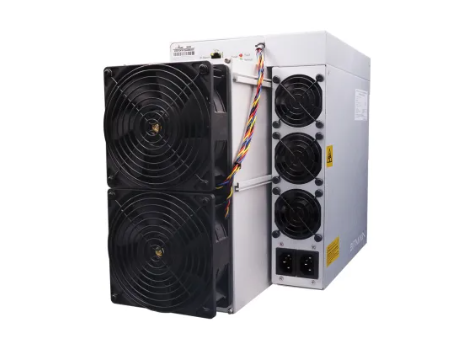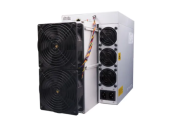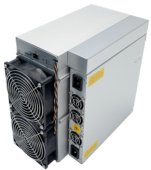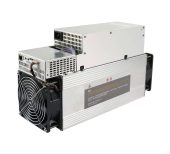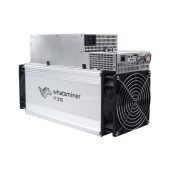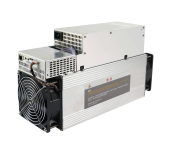Description
The new Antminer KA3, Bitmain overtakes all its competition and positions itself on the podium as one of the most profitable asics.
The leading chip company announced on 13 September a new mining device for the Kadena cryptocurrency with a mining power of 173 Th and a power consumption of 3,150w/hour.
This machine is called Antminer KA3, the first Kadena machine to make its way into the Bitmain family. The efficiency of this machine so far is unique and unmatched as it delivers around 19.2 Watts per TH.
It should also be noted that the miner of the Blake-2s Kadena algorithm is considered an industrial machine, not only for its power consumption but also for its high noise level, between 70-80db, factors that you should take into account if you want to get one of them.
Mining the Blake 2s Kadena (Antminer KA3)
Mining the Blake2s algorithm in the Kadena network refers to the process of validating transactions and securing the network using the Blake2s algorithm.
- Blake2s hashing algorithmBlake2s is a cryptographic hashing algorithm used in Kadena mining. It is a variant of the Blake2 algorithm used to hash blocks on the blockchain and ensure the integrity of transactions on the network.
- Proof-of-Work (Proof of Work)In the Kadena network, mining is performed through a Proof-of-Work (PoW) consensus algorithm using Blake2s. Miners compete to solve complex mathematical problems using their processing power and find a valid hash value that meets certain requirements set by the algorithm. The first miner to find the correct hash value has the opportunity to add a new block to the blockchain and receive rewards.
- Mining hardwareBlake2s mining in Kadena can be carried out using specialized hardware known as ASICs (Application-Specific Integrated Circuits) designed specifically for this algorithm. These devices are highly efficient in computing hash operations and provide increased processing power compared to conventional GPUs or CPUs.
- Mining poolsAs with other cryptocurrencies, Kadena miners have the option to join mining pools. Mining pools allow miners to combine their processing power and increase their chances of solving blocks and receiving rewards on a more regular basis. Rewards are distributed among pool members based on their contribution to the total hash power of the pool.
- Profitability and considerations: The profitability of Blake2s mining in Kadena depends on several factors, such as the cost of electricity, the price of the mined token (KDA), the difficulty of the network and the efficiency of the hardware used. It is important to consider these factors and perform profitability calculations before embarking on mining.
Why do you think Bitmain became interested in the Kadena project?
This cryptocurrency, KDA, has a large development team that includes former Microsoft, Apple or Bitcoin engineers, as well as good advisors that complement in generating a great confidence in the project.
Bitmain, has joined the large number of companies cooperating with Kadena, and let's not be surprised if we see a lot of adoption and that the project continues to grow exponentially.
Large ex - changes such as Binance, KUcoin, Crypto.com ... have this currency for their users to trade with it.
Undoubtedly, it is a Blockchain that has a lot of future and the potential to reach the TOP20 level.
KDA Token
The KDA token, short for "Kadena", is the native cryptocurrency of the Kadena blockchain network.
- Function and utilityKDA is used as the native currency in the Kadena network. It has several functions and utilities within the Kadena ecosystem:
- Payment of fees: Users must pay a certain amount of KDA as a fee for sending transactions, executing smart contracts and performing operations on the Kadena network.
- Participation in governance: KDA holders have the opportunity to participate in the governance of the Kadena network. This involves voting on improvement proposals and making decisions related to the development and evolution of the network.
- Value storage: In addition to its usefulness within the ecosystem, users can maintain KDA as a form of value storage or long-term investment.
- Supply and issuanceTotal supply of KDA is fixed and limited. Based on information available through September 2021, the maximum supply of KDA is 100 million tokens. No additional issuance beyond this maximum supply is foreseen.
- Markets and exchangesThe KDA token is listed on several cryptocurrency exchanges, allowing users to buy, sell and trade it. The price of the KDA is subject to supply and demand on these exchanges, as well as other external factors that may influence its value.
- Underlying technology: Kadena is a blockchain platform that combines multiple blockchains into a single network, enabling greater scalability and performance. It uses a hybrid consensus based on Proof-of-Work (PoW) and Proof-of-Stake (PoS) called "BFT-POW". This consensus approach combines the security of PoW with the efficiency and scalability of PoS.
- Use cases: Kadena is focused on providing blockchain solutions for enterprises and business applications. Its technology is designed to enable decentralized applications and trusted, scalable smart contracts, providing opportunities in areas such as finance, supply chain, asset registry and more.
